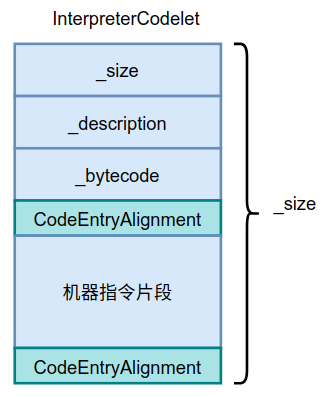第11篇-认识Stub与StubQueue
在 第10篇-初始化模板表 我们介绍过TemplateInterpreter::initialize()函数,在这个函数中会调用TemplateTable::initialize()函数初始化模板表,随后会使用new关键字初始化定义在AbstractInterpreter类中的_code静态属性,如下:
static StubQueue* _code;
由于TemplateInterpreter继承自AbstractInterpreter,所以在TemplateInterpreter中初始化的_code属性其实就是AbstractInterpreter类中定义的_code属性。
在initialize()函数中初始化_code变量的代码如下:
// InterpreterCodeSize是在平台相关
// 的templateInterpreter_x86.hpp中
// 定义的,64位下是256 * 1024
int code_size = InterpreterCodeSize;
_code = new StubQueue(
new InterpreterCodeletInterface,
code_size,
NULL,
"Interpreter");
StubQueue是用来保存生成的本地代码的Stub队列,队列每一个元素对应一个InterpreterCodelet对象,InterpreterCodelet对象继承自抽象基类Stub,包含了字节码对应的本地代码以及一些调试和输出信息。下面我们介绍一下StubQueue类及相关类Stub、InterpreterCodelet类和CodeletMark类。
1、InterpreterCodelet与Stub类
Stub类的定义如下:
class Stub VALUE_OBJ_CLASS_SPEC { ... };
InterpreterCodelet类继承自Stub类,具体的定义如下:
class InterpreterCodelet: public Stub {
private:
int _size; // the size in bytes
const char* _description; // a description of the codelet, for debugging & printing
Bytecodes::Code _bytecode; // associated bytecode if any
public:
// Code info
address code_begin() const {
return (address)this + round_to(sizeof(InterpreterCodelet), CodeEntryAlignment);
}
address code_end() const {
return (address)this + size();
}
int size() const {
return _size;
}
// ...
int code_size() const {
return code_end() - code_begin();
}
// ...
};
InterpreterCodelet实例存储在StubQueue中,每个InterpreterCodelet实例都代表一段机器指令(包含了字节码对应的机器指令片段以及一些调试和输出信息),如每个字节码都有一个InterpreterCodelet实例,所以在解释执行时,如果要执行某个字节码,则执行的就是由InterpreterCodelet实例代表的机器指令片段。
类中定义了3个属性及一些函数,其内存布局如下图所示。

在对齐至CodeEntryAlignment后,紧接着InterpreterCodelet的就是生成的目标代码。
2、StubQueue类
StubQueue是用来保存生成的本地机器指令片段的Stub队列,队列每一个元素都是一个InterpreterCodelet实例。
StubQueue类的定义如下:
class StubQueue: public CHeapObj<mtCode> {
private:
StubInterface* _stub_interface; // the interface prototype
address _stub_buffer; // where all stubs are stored
int _buffer_size; // the buffer size in bytes
int _buffer_limit; // the (byte) index of the actual buffer limit (_buffer_limit <= _buffer_size)
int _queue_begin; // the (byte) index of the first queue entry (word-aligned)
int _queue_end; // the (byte) index of the first entry after the queue (word-aligned)
int _number_of_stubs; // the number of buffered stubs
bool is_contiguous() const {
return _queue_begin <= _queue_end;
}
int index_of(Stub* s) const {
int i = (address)s - _stub_buffer;
return i;
}
Stub* stub_at(int i) const {
return (Stub*)(_stub_buffer + i);
}
Stub* current_stub() const {
return stub_at(_queue_end);
}
// ...
}
这个类的构造函数如下:
StubQueue::StubQueue(
StubInterface* stub_interface, // InterpreterCodeletInterface对象
int buffer_size, // 256*1024
Mutex* lock,
const char* name) : _mutex(lock)
{
intptr_t size = round_to(buffer_size, 2*BytesPerWord); // BytesPerWord的值为8
BufferBlob* blob = BufferBlob::create(name, size); // 在StubQueue中创建BufferBlob对象
_stub_interface = stub_interface;
_buffer_size = blob->content_size();
_buffer_limit = blob->content_size();
_stub_buffer = blob->content_begin();
_queue_begin = 0;
_queue_end = 0;
_number_of_stubs = 0;
}
stub_interface用来保存一个InterpreterCodeletInterface类型的实例,InterpreterCodeletInterface类中定义了操作Stub的函数,避免了在Stub中定义虚函数。每个StubQueue都有一个InterpreterCodeletInterface,可以通过这个来操作StubQueue中存储的每个Stub实例。
调用BufferBlob::create()函数为StubQueue分配内存,这里我们需要记住StubQueue用的内存是通过BufferBlob分配出来的,也就是BufferBlob其本质可能是一个StubQueue。下面就来详细介绍下create()函数。
BufferBlob* BufferBlob::create(const char* name, int buffer_size) {
// ...
BufferBlob* blob = NULL;
unsigned int size = sizeof(BufferBlob);
// align the size to CodeEntryAlignment
size = align_code_offset(size);
size += round_to(buffer_size, oopSize); // oopSize是一个指针的宽度,在64位上就是8
{
MutexLockerEx mu(CodeCache_lock, Mutex::_no_safepoint_check_flag);
blob = new (size) BufferBlob(name, size);
}
return blob;
}
通过new关键字为BufferBlob分配内存,new重载运算符如下:
void* BufferBlob::operator new(size_t s, unsigned size, bool is_critical) throw() {
void* p = CodeCache::allocate(size, is_critical);
return p;
}
从codeCache中分配内存,CodeCache使用的是本地内存,有自己的内存管理办法,在后面将会详细介绍。
StubQueue的布局结构如下图所示。

队列中的InterpreterCodelet表示一个小例程,比如iconst_1对应的机器码,invokedynamic对应的机器码,异常处理对应的代码,方法入口点对应的代码,这些代码都是一个个InterpreterCodelet。整个解释器都是由这些小块代码例程组成的,每个小块例程完成解释器的部分功能,以此实现整个解释器。


